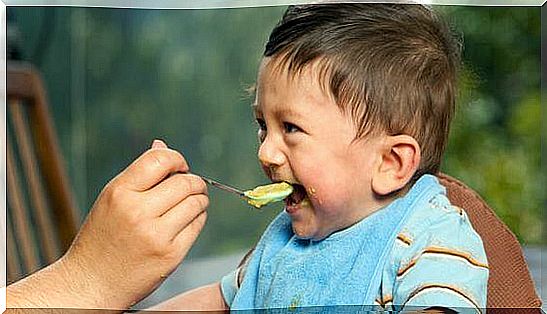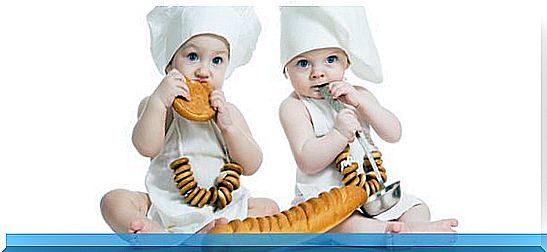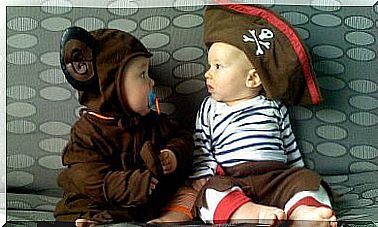Baby’s First Meals: How To Incorporate Solids Into His Diet?

The best diet during the first 6 months of life is breast milk. But, after that age, the baby must complement it with what will be his first meals, for which you must incorporate solids into the diet. This is when fears and doubts appear.
There is no reason to rush to incorporate solids into your child’s diet and, of course, it would be better to consult your pediatrician beforehand so that he or she can point out the right time to offer him his first baby foods.
Surely you are confused and stunned when receiving such opposite and confusing series of family advice. Therefore, in this article we help you prepare for this food transition. With what start? What foods should I not give him under any point of view? Why don’t you eat? Discover it here!
Baby’s First Meals: When to Add Solids?
Most babies are ready to incorporate solids from 5 or 6 months, although each child manages their times. However, there are a number of signs that give warning regarding the preparation of the baby to eat these foods:
- Can you keep your head up? One of the signs is that the baby has control of his head and can get up on his own or with some help.
- Are you interested in food? If the child opens its mouth when a food is approached or they watch carefully how the elderly eat, it is probably time to introduce complementary feeding.
- Can you put food from a spoon down your throat and swallow it? If your child can close his mouth around the spoon while using his lips and tongue to swallow food, then he is probably ready to taste his first porridge.
- Weight gain in direct proportion to increased appetite. Babies are generally ready to add solids to their diet once they have doubled their birth weight. At the same time, you will notice that he has more and more appetite, leaving him hungry.
- Sit well when you have support. If the child manages to sit in his chair to eat while maintaining an upright position, it is an indication that it is the moment where he can gradually begin to swallow food well.
Do not forget to read: Suggestions for introducing complementary feeding.
How to feed it?
Start small, with small spoonfuls and talking to your baby during the process, as he may not know what to do at first and may seem confused. In addition, he may play with food in his mouth or in his hand, reject it completely or wrinkle his nose as a gesture of disapproval or distrust.
So it shouldn’t frustrate you that their first solid foods end up on your baby’s hair, face, hands, or bib. Avoid that your child eat while crying remember to increase the portions offered to the baby gradually.
Experts currently recommend a technique known as Baby Led Weaning when introducing complete feeding. This feeding method, as stated in an article published in the “Italian Journal of Pediatrics”, will help the baby to adapt to the textures and flavors of food more easily.
The beginning is not easy or fast, since introducing solids requires a high dose of patience. That is why consider that that special and awaited moment that you face with so much energy can become exhausting and exhausting due to the lack of habit of your little one. Do not get frustrated!

In this sense, pediatricians advise taking the first baby meals calmly and affirm that the first semisolids should not replace breast milk.
Likewise, the experts add a piece of advice: the mother should not be anxious or add “seasonings” to whet the child’s appetite. Many mothers make the gross mistake of adding honey, sugar, salt, and oil to the baby food.
Of course, avoid that strategy that is not only unhealthy for children of such a young age, but also keeps them away from good eating habits. Also stay away from commercial porridges with colorants and additives, as they tend to contain large amounts of sugar, according to a study published in 2017. Be patient, the process requires time and dedication!
The time has come: what foods do we start with?
As we have said, the idea of incorporating solids or semi-solids initially has a learning function rather than nutrition.
At this stage, you can start giving it:
- Vegetable purees. It tends to be the first solid food your child’s pediatrician will include in their diet. One at a time, you must make potato, carrot and pumpkin porridge, in that order. Then you can make the famous tricolor puree, consisting of the mixture of both vegetables.
- Fruit porridge. At the same time, they will allow you to incorporate solids such as pear and apple, mainly in the form of compote, since they are less acidic. They also have a consistency that is easier to digest and a greater tolerance on the part of the baby. Any fruit can be offered in the form of porridge, in a natural state or cooked as a compote, as it is the way you present it, it will provide vitamins, proteins, minerals and fibers.
- Cereals. The next step to give your child the first meals is to incorporate cereals such as polenta and vitin at first, rice and small soup noodles later. And here it is essential to be careful because you must pay attention that they do not have gluten, a protein present in wheat, oats, barley and rye that can be poorly tolerated by minors.
Experts suggest incorporating solids gradually, one at a time, waiting at least two days between food and food in order to perceive possible allergic reactions to any of them. Diarrhea, vomiting, bloating, rash, and shortness of breath are warning signs.
Your doctor will likely advise against foods that tend to be allergens such as soy, dairy products, eggs, wheat, fish, peanuts, and chocolate.

Incorporating solids: Additional considerations on your first meals.
Of course, it is an excellent initiative for the child to get used to eating a wide variety of foods but remember that the transition will take time since it involves getting used to each new taste and texture.
Don’t be upset if he doesn’t seem to like a flavor, offer it later. Also, do not leave any food out of the baby’s diet for the simple reason that you do not like it. Do not forget to give him water and even try including natural juices in his diet, he will love them!
You may also be interested in: The guide that helps you with complementary feeding.
Allergies and foods to avoid
Specialists suggest not including certain foods before the year, especially if there is a family history of allergies. On the other hand, certain foods should be avoided until the age of 3 years since they do not dissolve quickly in the mouth so the child can choke. So, avoid:
- Chocolate
- Caramel sauce
- Soy
- Gluten (Wheat, oats, barley, rye)
- Honey
- Peanuts
- Hard candies
- Dry fruits
Incorporating solid foods, a great step in the diet
Remember that from 6 months you can start incorporating solid foods into the baby’s diet. Start by mashing fruits and vegetables and later include products with different textures.
A good food education is the basis for correct habits in the future. These will help your child prevent diseases like obesity and diabetes. For this reason you have to put effort into this task.










